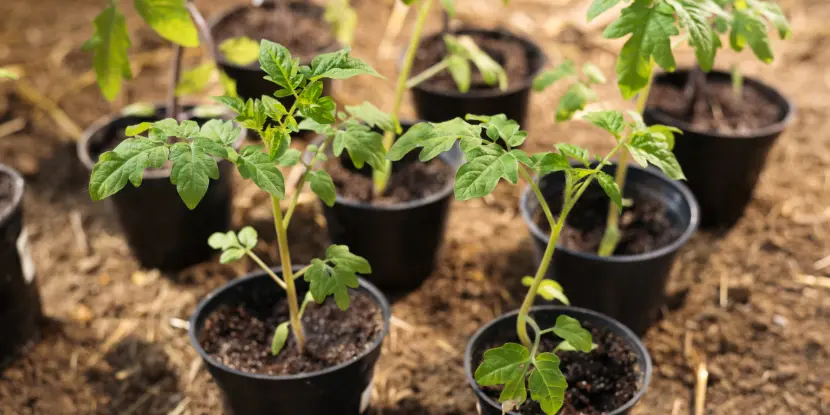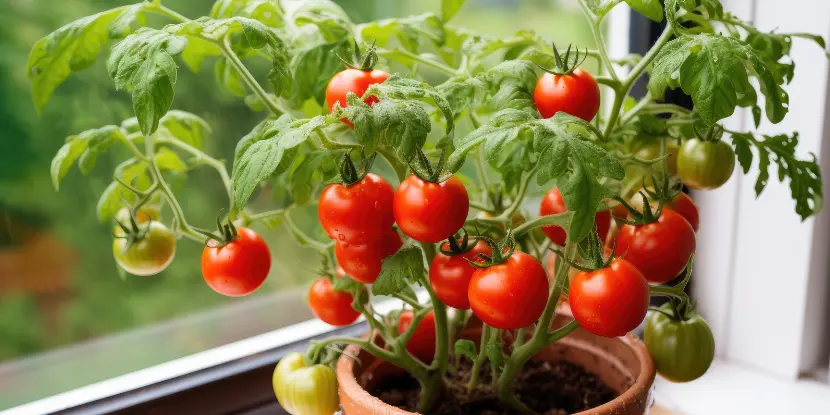Now, more than ever, is a great time to grow your own vegetables!
Our video shows how to plant tomatoes in pots and care for them for a bountiful harvest.
You don’t need a massive backyard to do this — a small balcony or patio will suffice. As a bonus, container gardening gives you greater control over light, temperature, pest management, and soil composition.
Be sure to follow us on Instagram and share what you’re growing with us. #Anawaltathome
Choosing the Right Tomato Varieties
Some tomato varieties are eminently suited to container cultivation. These include:
- Patio Princess (the name says it all)
- Tumbling Tom
- Moneymaker
- Better Bush
Other factors include:
- Size: Determinate or “bush” varieties tend to be more compact and suitable for smaller containers, while indeterminate or “vining” varieties may require larger pots or support structures.
- Light requirements: Some tomato varieties require full sun, while others can tolerate partial shade. Choose a variety that matches the conditions of your growing space.
- Fruit size: Consider the size of the fruit the plant produces. Smaller cherry tomatoes are best for salads and appetizer trays, while larger varieties are better for sandwiches and cooking.

Young tomato plants in pots ready to be transplanted to larger pots.
Choosing the Right Pot
- Make sure your container provides adequate space for root growth. A general rule of thumb is to have at least 5 gallons (19 liters) of soil for each tomato plant.
- Choose a pot with good drainage. Tomatoes prefer well-drained soil, and their roots can rot if left in standing water.
- Consider using self-watering containers or adding a drip irrigation system to ensure consistent watering and prevent over or under-watering.
Light
Tomatoes are sun-loving plants. Here’s how to keep your plants happy.
- Tomatoes perform best when they receive at least 6–8 hours of direct sunlight daily.
- If you’re growing potted tomatoes on a balcony or patio, place the pots in a south-facing area to maximize sunlight exposure.
- In case natural light is insufficient, especially in early spring or cloudy climates, use grow lights to supplement natural light.
Temperature
- Tomatoes love warm conditions, with ideal daytime temperatures between 70–85°F (21–29°C).
- Nighttime temperatures should be between 55–70°F (13–21°C) for optimal growth and fruit set.
- Temperatures below 50°F (10°C) can stunt growth and hinder fruit development. Protect your plants from cold snaps.
- Conversely, temperatures above 90°F (32°C) can cause tomato flowers to drop and impede fruit setting. If possible, provide shade during extreme heat.
- If growing indoors or in a greenhouse, use fans and ventilation to maintain a stable temperature and prevent overheating.

An indoor potted tomato plant laden with fruit.
Soil
To ensure your potted tomatoes thrive, follow these soil recommendations:
- Tomatoes prefer well-draining soil. Use a high-quality potting mix designed for containers rather than garden soil.
- Tomatoes are heavy feeders. Choose a potting mix enriched with compost or a slow-release fertilizer to provide essential nutrients throughout the growing season.
- Tomatoes grow best in slightly acidic soil with a pH range of 6.0 to 6.8. You can test the soil pH with a home test kit and adjust it with lime (to raise pH) or sulfur (to lower pH).
- Incorporate organic matter like compost or well-rotted manure into the potting mix to improve soil fertility and structure.
- If reusing potting soil from the previous year, replenish its nutrient content with fresh compost or fertilizer.
Planting Your Tomatoes
- Fill your chosen container with a high-quality potting mix. Avoid garden soil, which may contain pests and diseases.
- Dig a hole slightly larger than the root ball of your transplant. Remove the lower leaves from the stem and bury it up to the top set of leaves. Buried stems will develop additional roots.
- Gently backfill the hole, firmly packing the soil around the stem.
- Water thoroughly. Soil should be evenly moist but not saturated.

Healthy tomato plants growing on a balcony.
The Lasagna Layering Method for Planting
Just like great pasta, great tomato plants start with a good base:
- Fill your pot with 1.5 cubic feet of potting soil.
- Add 1/4 cups of Kellogg’s G & B Tomato Vegetable fertilizer
- Add 1/4″ layer of Kellogg’s Organics Worm Gro
- Add 1″ of compost
Caring for Your Potted Tomatoes
- Water regularly to keep the soil moist but not soggy. Inconsistent watering can cause issues like blossom end rot or cracking fruit.
- Fertilize every few weeks with a balanced fertilizer according to package instructions.
- Monitor for pests and diseases and take immediate action to prevent damage to your plants.
- Stake or use tomato cages for indeterminate varieties to give them support as they grow.
- Pinch off any suckers (small shoots growing in the joint between the main stem and a branch) to encourage bigger, healthier fruit.
Harvesting Your Potted Tomatoes
- Depending on the variety, tomatoes can mature in 50 to 100 days. Check your seed packet or plant label for an estimated harvest time.
- When ripe, gently twist or cut the tomato from the vine. Don’t pull on it, or you may damage the plant.
- If you pick tomatoes before they’re fully ripe, place them in a paper bag with an apple to help them ripen faster.

A delicious and healthy pasta dish with fresh cherry tomatoes and basil.
Enjoy!
Indulge in the fruits of your labor! We don’t need to tell you how to enjoy tomatoes — they belong in salads, pizzas, pasta, and more! Please tag #anawaltathome so we can appreciate your creations.
FAQs: Growing Tomatoes in Pots
Q: What size pot is best for growing tomatoes?
We recommend a pot at least 18 inches in diameter and 18 inches deep. This size provides enough space for the roots to expand and ensures proper drainage. Larger pots can support bigger plants and yield more fruit.
Q: How often should I water my potted tomato plants?
Tomato plants in pots need consistent watering to thrive. Typically, they should be watered once every one to two days, especially during hot and dry weather. Keep the soil kept moist but not saturated. If the top inch of soil feels dry, it’s time to water your plants.
Q: Do potted tomato plants need fertilizer?
Mix a balanced, slow-release fertilizer at planting time. Apply a liquid fertilizer every 2–4 weeks during the growing season to promote healthy growth and fruit production.
Q: Can I grow tomatoes in containers indoors?
Yes, if you provide adequate light. Place the pots near a south-facing window or use grow lights to ensure the plants receive 14–16 hours of light daily. Adequate ventilation and warm temperatures are also crucial for indoor tomato growth.
Q: What temperatures do tomato plants prefer?
Tomatoes do best in temperatures between 70-85°F (21-29°C) during the day and 60-70°F (15-21°C) at night. Protect your plants from frost, as tomato plants are sensitive to cold temperatures.
Q: How long does it take for tomatoes to grow in pots?
On average, it takes 60–80 days for tomato plants to produce ripe fruit after transplanting into a pot. Cherry and grape varieties may ripen sooner, while larger beefsteak or heirloom varieties may take longer.
Q: Can I reuse the soil from my potted tomato plant?
We don’t recommend it. Reused soil may be depleted of nutrients and harbor diseases. Instead, mix fresh potting soil with compost before planting
Q: What type of soil is best for growing tomatoes in pots?
A high-quality, well-draining potting mix is ideal for potted tomatoes. Avoid using garden soil, which can compact and limit root growth. Enhancing the potting mix with compost or organic matter can improve nutrient availability and water retention.
Q: How much sunlight do potted tomato plants need?
Tomatoes need at least six to eight hours of direct sunlight daily. To ensure optimal growth and fruit production, place your pots in a sunny location, such as a south-facing patio or deck.
Q: Is it necessary to prune tomato plants grown in pots?
Pruning can improve air circulation and focus the plant’s energy on fruit production. Remove suckers (the small shoots growing between the main stem and branches) and any yellow or diseased leaves. Regular pruning helps maintain the plant’s health and vigor.
Q: How do I support my potted tomato plants?
Supporting potted tomatoes with stakes, cages, or trellises prevents the plants from toppling and keeps the fruit off the soil. Install these supports at planting time to avoid damaging the roots later.
Q: What pests should I watch for on my potted tomato plants?
Monitor your plants for common pests such as aphids, spider mites, and whiteflies. Use insecticidal soap or neem oil to help control infestations, or introduce beneficial insects like ladybugs. Proper care and monitoring can prevent most pest issues.
Q: How can I prevent diseases in my potted tomato plants?
Ensure your pots have good drainage, avoid overhead watering, and provide adequate spacing for air circulation. Remove any diseased leaves promptly and use sterilized tools. Crop rotation and resistant varieties can also mitigate disease risks.
Q: When should I harvest tomatoes grown in pots?
Harvest tomatoes when they’re fully colored and slightly soft to the touch. Depending on the variety, this may take anywhere from 50 to 85 days after planting. Regularly check your plants and pick tomatoes as they ripen to encourage continuous fruit production.

